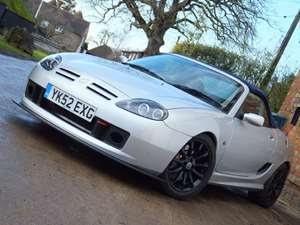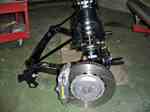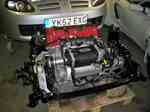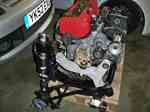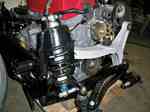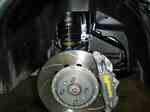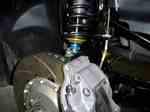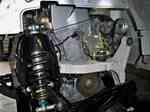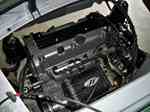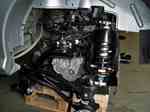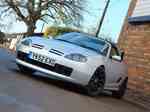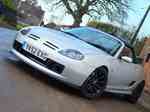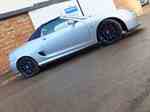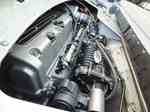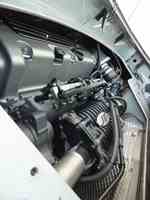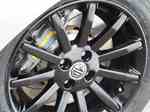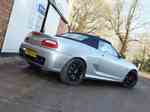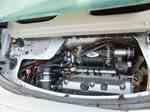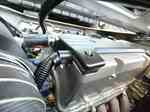Giving standard MG's more power than the factory originals has always been a trait at Maidstone Sports Cars. From MGB V8 conversions to RV8 5 litre engine swaps along with appropriate brake and suspension upgrades to match the power.
Maidstone Sports Cars is world renown for our Honda engine conversion into the Lotus Elise/Exige range having completed over 200 conversions to date.
The S1 Elise drivetrain is pure MGF so the Honda conversion parts we have developed for the Lotus Elise should also be mainly compatible with the MGF/TF. So why not put the Honda Type R engine and 6 speed gearbox into the MGF/TF? I know it's been done before but not on a commercial basis and certainly not to this level of development. This was to be a thorough engineering exercise which would deal with the separate issues of suspension, brakes, aerodynamics and drivetrain.
Having raced successfully in the MGF Cup and Challenge, knowing the limitations of Hydra gas suspension, we decided to opt to use the MG TF with its more conventional coil over suspension and stiffer body.
A Lotus Elise S1 with a normally aspirated Honda (223bhp) weighs roughly 735kg and produces stunning performance to a power to weight ratio of over 300bhp per ton. As a TF weighs about 1150kg, we decided the engine would need some extra power and so it was decided that we had to supercharge it up to 350bhp. This we calculated should be enough to propel the TF to 0-60mph in around 4 seconds and 0-100mph in under 10 seconds and onto a top speed of 165 mph. Obviously with this sort of power the brakes and suspension would need extensive work to deal with the 190% power increase.
In hindsight the actual engine conversion would be quite straight forward, the trick would be to make the rest of the car suitable and safe. The three areas needing the most attention were brakes, suspension and front aero dynamics. These would have to be modified otherwise the first test drive would have probably left someone in a ditch.
1) Brakes
Even though the MGF Trophy AP 4 pot calipers do wonders to a TF, they would not be sufficient for the power going into the car.
We ended up specifying our own brake set up which we had made using AP as the main supplier. The front discs were 315mm AP aluminium belled disc with Large AP 4 pot callipers. The rears were 290mm AP aluminium belled discs with AP 4 pot callipers. The handbrake would be taken care of using small spot calipers. Braided brake flexible hoses and DOT 5.1 fluid would make up the full brake set up along with an internal AP brake bias valve. The standard TF master cylinder was retained as was the ABS system.
As the vehicle was to be used and tested on track extensively, our braking system was deemed by some to be over the top. But with the performance that was to come out, we felt the bigger the better.
2) Suspension
Having studied the standard MG TF set up, it was decided to modify the front lower wishbones to allow extra negative camber. The wishbones were duly modified and strengthened and the bushes were upgraded to polyurethane.
Having worked continually over the years with Nitron Racing in our Lotus work, we choose Nitron again to help develop a new single way coil over damper for the TF. Both subframes had to be modified to take a conventional top damper mount. A lot of development time was spent working on the required valving and optimum spring rates. This would allow us to adjust the ride height and damping.
It was also decided that some of the rear suspension joints would be changed to rose joints to improve location. The standard TF toe link was replaced with one of our own design which is fully adjustable and more suitable for our install. We also utilised an original MGF Cup front anti roll bar, which was mounted on our own custom built mounts with adjustable rose jointed links. The rear bar was kept standard size but relocated and made it fully adjustable with rose jointed links.
The major structural work was carried out to the front and rear subframes. The front was quite straightforward replicating the MGF Cup items and being fully seam welded. The strut towers were modified to accept the Nitron dampers and the front crash boxes were removed and replaced with welded tube. Certain areas were also boxed in and braced.
The rear extensive modification to accept fitment of the Honda engine and gearbox. All sections were boxed in and reinforced and then seam welded.
Both subframes and associated parts were then sandblasted and powder coated before reassembly.
The one beauty of the MGF/TF is that the suspension and drivetrain can be assembled off the car before installation into the vehicle.
We prepared a Honda K20A2 engine and gearbox for the install. A Supercharger and ITR manifold were fitted to the engine along with a baffled sump to stop oil surge when cornering hard on track.
The completed drivetrain was fitted into the powder coated subframe using our complete engine mount set. We then fitted an oil cooler to help control oil temps which we know from experience can rise when driven hard. All coolant hoses were silicon with stainless clamps as with all things MSC it always has to look right using only quality products which we pride ourselves on. Gear cables were modified and fitted to our gear linkage kit and adjusted.
A stainless 4-1 exhaust manifold was fabricated and fitted to work with a sports cat and free flow sports exhaust all in stainless steel. At this stage the rear subframe was ready for installation as a complete unit.
Once installed it was time to connect all the ancillaries and all hoses etc. and plumb everything in.
To run the supercharger a higher fuel pressure was needed so a fuel pressure regulator was fitted.
Driveshafts were measured and fabricated to fit this application using our lotus compatible ends with Honda inboards.
Our engine link loom was fitted and wired into the Honda engine loom utilising the Honda OE ECU and a Hondata K100 board which would allow us to map the engine. Certain issues regarding dash controls and warnings were duly sorted. The cooling fans we controlled from the ECU and the OE immobilizer and alarm were retained.
3) Aerodynamics
Having driven standard TF's at speed they do have a tendency for the front to lift and steering lighten significantly. Considering this TF would be capable of speeds in excess of 150mph, this area needed urgent attention. In standard form the front aero is very poor but the solution is relatively simple. The problem is that the air passes through the front grill and radiator then hits the spare wheel well and the air is forced downwards pushing the front of the car up! What is needed is to redirect this air either to the sides or upwards.
To help with the issue, we fabricated a front splitter using honeycomb aluminium (immensely strong but light) to further keep the front truly planted.
We decided to keep the car cosmetically looking remarkably standard. The alloy wheels were repainted black to show off the larger front and rear brakes.
Internally a 6 speed gear knob was the only give away signs of the hidden potential. We had however lowered the driver's seat frame by approx. 30mm as you do seem to sit on rather than in the TF.
The Result
The supercharger install is a well proven unit which we have fitted for road/track/race applications across the Lotus range for years, but we were very keen to see the results now it was fitted into the TF.
With fully adjustable suspension we were able to set the car up as we wanted with negative camber all round and a lower ride height and adjustable anti roll bars. The brakes were bled and adjusted and all fluids were added.
Start-up was uneventful with everything working as it should. All systems were checked and the engine and water temps were brought up and stabilized at 80°C.
On the car's first road test, the engine pulled strongly from idle as with a supercharger its working all the time so power is there all the time. The only way of describing it is if a big hand starts pushing you in the middle of your back and just keeps pushing and pushing. The power seems endless and the delivery seamless and the noise as the supercharger screams are addictive. The power just keeps on coming all the way up to the red line at 8600rpm.
This car is like the Martini Girl "anytime, anyplace, and anywhere". Gear changes become irrelevant as it will pull from any revs in any gear, it is just so tractable, and with the remap lowering the VTEC point down to 4250 rpm it is on cam for over 4500 rpm. It is so civilised when driven normally no one would know what performance is lurking under its standard exterior and this is half the fun.
All of the suspension upgrades have also transformed the TF into a real track weapon. Everything is just so positive and direct, yet not unduly harsh. The work with the dampers and spring rates has really paid off and no TF has ever felt this good on road or track!
The brakes are also in a different league to anything ever fitted to a TF considering the performance available. They are phenomenal with no sign of fade, no matter how often and how hard they are applied.
Like all projects at Maidstone Sports Cars this car has been finished to a very high standard with all components powder coated, nuts bolts zinc plated and abundant use of stainless fixings throughout. Perhaps the ultimate Q car.
To highlight the engine conversion, a polycarbonate engine cover has been fitted so our work can be seen first-hand.
The original brief was just to fit a Honda Type R engine and gearbox into a MG TF, but like most projects it has ended up with something completely different.
We never envisaged a redesign of the suspension and brakes to such a level or dealing with the poor front end aero, but the end results are truly fantastic and worth it 100%.
Maidstone Sports Cars have turned a lowly TF into supercar performance material.
Specification
| Engine |
|---|
|
| Exhaust |
|
| Gearbox |
|
| Cooling |
|
| Suspension |
|
| Brakes |
|
| Subframes Front and Rear |
|
| Wheels and Tyres |
|
